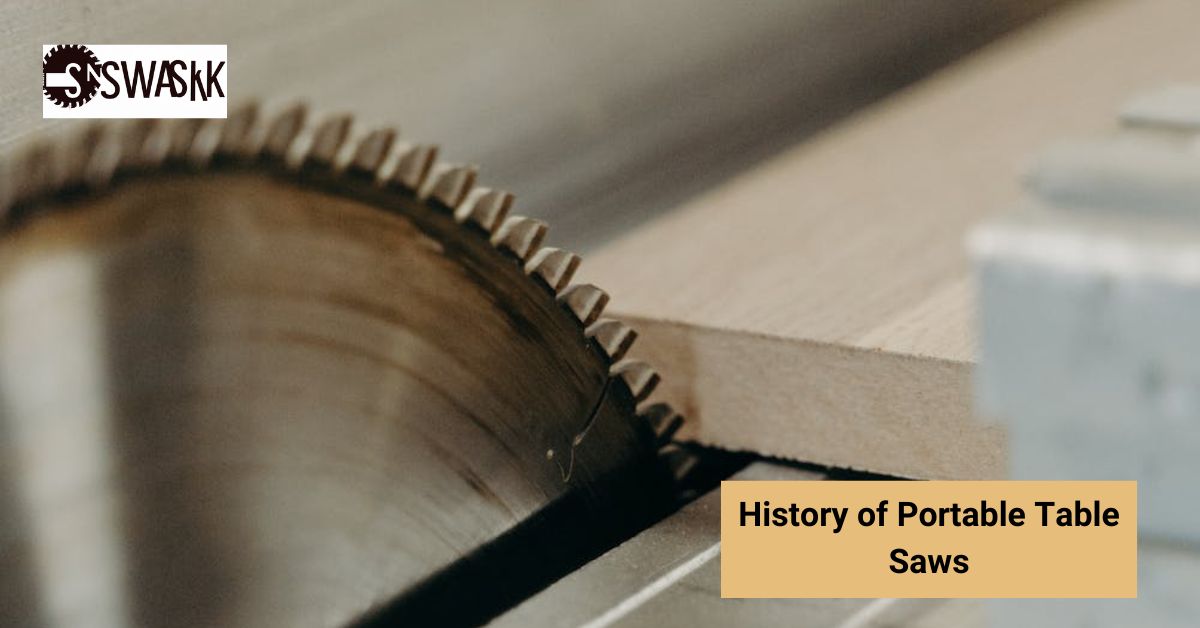History of Portable Table Saws: A Comprehensive Journey Through Time

A portable table saw brings a revolution in the woodworking industry. These saws became very famous due to their portability and foldability. From basic hand saws to complicated ones, how they changed and improved over time is outstanding.
The portable saw developed in the 20th century. Before that, a simple hand-operated saw was used. The history of the portable saw is the story of how simple tools turned into today’s easy and advanced cutting.
In this article, I will demonstrate portable table saws’ origins, developments, and technological advancements, highlighting their impact on the woodworking and construction industries.
Let’s explore the history of portable table saws in more detail.
Early Beginnings (The Pre-Industrial Era)
The Birth of the Saw:
The history of portable table saws is very old, dating back to industrialization. Initially, woodworkers used manual hand-operated saws made from iron or steel with wooden handles. These saws were simple in design but took more effort for a precise cut.
The First Use:
The saw was first used in woodworking history by an ancient civilization. The Egyptians, famous for their architectural skills, used these simple saws to cut wood and stone. These early tools were essentially teethed blades attached to a handle, operated by pulling back and forth. Although this method was effective at that time but the cutting accuracy was not as good.
Woodworking Evolution:
The process of hand saws to modern saws evolved as civilization evolved. The transition from hand-saw to mechanical saw marks a significant leap in woodworking technology. During the Middle Ages, sawmills powered by water and wind emerged, introducing a more automated approach to sawing. However, these were stationary saws and not portable.
The progression from simple hand-operated saws to more complex mechanical systems highlights a continuous quest for improvement and efficiency in woodworking tools, eventually leading to the portable table saws we know today.
The Industrial Revolution and the Birth of Table Saws
The Transformation from Hands to Machines:
The industrial revolution happened from the late 18th to the early 18th century. This was a big change in the industry, where people were doing everything hand, and machines started doing a lot of work.
At this time, the table saw was introduced. They weren’t as good as today’s, but they were cool back then. These early saws used steam engines first and then passed electricity, significantly reducing the manual effort required in woodworking.
Addition of Blade:
Improvements in blade design significantly enhanced the efficiency and effectiveness of these early saws. Blades became thinner, sharper, and more durable, allowing precise cuts. The introduction of interchangeable blades for different cuts was another significant advancement.
The impact of these innovations made a really big difference. They helped people get more work done and made it easier to do detailed stuff in woodworking.
However, these early saw models were not as good as current portable saws. They were heavy and difficult to move around, designed more for stationary use in factories and workshops.
The 20th Century: Portable Table Saws Emerge
Birth of Portable Table Saw:
In the 20th century, the portable table saw brought a significant revolution in the history of woodworking tools. Particularly after World War II, the technological improvements were cool, making the table saw lighter, working better, and easier to use.
The need for a portable table saw was very important. Carpenters and woodworkers needed such a tool that could be carried out to different places instead of stationary saws that were heavy to carry out. This led to the birth of portable table saws, which became famous due to their mobility and flexibility.
Safety and Convenience Upgrade:
Manufacturers also began to focus on user safety and convenience. Features such as blade guards and riving knives were introduced to reduce the risk of accidents. Adjustable components, such as fences and miter gauges, enhanced the versatility of these tools, allowing for a broader range of cuts and applications.
In the 20th century, portable table saws improved performance and became a big part of woodworking history. These changes in portable table saws tell how people worked hard to make things better and more efficient. The legacy of this era is evident in the modern portable table saws, which continue to evolve with ever more advanced features and capabilities.
Advancements in Safety and Precision
As table saws became more widely used in the 20th century, the importance of safety features became increasingly evident. Early table saw models lacked essential safety mechanisms, leading to a higher risk of accidents.
Addition of Blade Guard:
The blade guard was introduced in the middle of the 20th century, significantly enhancing user safety. These guards helped prevent accidental contact with the blade, reducing the risk of serious injuries.
In addition to safety, precision and accuracy have become a major focus for manufacturers and woodworkers.
For better control in angled cuts, the introduction of the fence improved the accuracy of cuts. Miter gauges were also added for better-angled cuts in measurements.
The Emergence of Laser Guide and Dust Collection:
The laser guide marked more precision in the cuts. These guides marked a line on the wood where the cut would be made, allowing for more accurate alignment and cutting.
Another notable advancement was integrating better dust collection systems, which kept the workspace cleaner and improved visibility while cutting, contributing to both safety and precision.
These advancements in safety and precision transformed portable table saws into more user-friendly and reliable tools. They allowed woodworkers to perform their tasks with greater confidence and accuracy.
The Digital Age and Smart Table Saws
The digital age brought more advancement in the development of portable table saws. Integrating a smart table saw has increased woodworking’s precision, efficiency, and safety.
Smart table saw uses advanced features such as digital controls, touchscreens, and automated systems to enhance user experience. Digital readouts provide real-time feedback on measurements, blade speed, and other critical parameters for more accurate and consistent cuts.
Furthermore, some smart table saws offer connectivity features, such as Bluetooth and Wi-Fi, allowing them to interface with smartphones and computers. This connectivity lets users monitor and control the saw remotely, track usage, and even download custom cutting patterns and settings.
These advancements in the woodworking industry not only reduce the time it takes for woodworkers to cut wood but also increase precision and accuracy. These tools are increasingly becoming the standard, replacing traditional models due to their advanced features and capabilities.
The Future of Portable Table Saws
The future of portable table saws will be more advanced features and innovations by ongoing technological developments and changing user needs.
Environment friendly features:
One of the important developments of portable table saw is the focus on taking care of how our actions affect nature and making decisions that help rather than harm. Manufacturers are exploring ways to make table saws more energy-efficient and environmentally friendly, including the use of renewable energy sources and sustainable materials.
